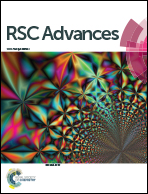Performance dependence of SWCNT/n-silicon hybrid solar cells on the charge carrier concentration in silicon substrates†
Abstract
In this work, single-walled carbon nanotube (SWCNT)/n-silicon based hybrid solar cells have been fabricated and characterized in order to investigate the effect of different doping levels/charge carrier concentrations in silicon. The SWCNT films were characterized by UV-Vis-NIR spectroscopy for optical absorption, photoluminescence spectroscopy for chirality determination, and resistivity measurements. The n-type silicon substrates were characterized by Hall-effect measurements for mobility of charges, charge carrier concentration, and resistivity measurements. Atomic force microscopy and scanning electron microscopy were employed to study the morphology of SWCNT films. The solar cells were characterized by current–voltage measurements under AM1.5 solar irradiance. We have found that a heavily doped silicon substrate does not result in a functional solar cell, whereas lightly doped silicon substrate produces much less photocurrent. The SWCNT/n-silicon solar cells with silicon substrate resistivity of 1.82 Ω cm and change carrier concentration of 2.33 × 1015 produced the best power conversion efficiency of 2.35% among the silicon substrates under investigation. These studies provide sufficient insight into material selection parameters for the SWCNT/n-silicon solar cell architectures to optimize device efficiencies.


 Please wait while we load your content...
Please wait while we load your content...